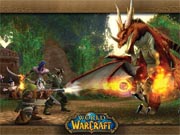German rating system targets violent computer games
 Berlin - Violent computer games are sparking controversy all over the world. Legislation recently passed in Germany in July, for example, makes it easier to put such games on the banned list following the introduction of a rating index. Yet what does it all really mean? Who sets the age recommendations for "normal" games? In Germany, at least, these roles have been in flux of late.
Berlin - Violent computer games are sparking controversy all over the world. Legislation recently passed in Germany in July, for example, makes it easier to put such games on the banned list following the introduction of a rating index. Yet what does it all really mean? Who sets the age recommendations for "normal" games? In Germany, at least, these roles have been in flux of late.
Games on Germany's banned list cannot be sold publicly. That includes any advertising and sales through mail order. The decision to flag a game is made by the Federal Department for Media Harmful to Young Persons (BPjM). Since the July 1 revision of the Protection of Minors Act, the agency has been granted even more authority.
That includes the authorisation to list games that propagate vigilante justice as the only solution to a problem. The criteria have also been expanded for the automatic inclusion of specific games in the list.
"The chance to list a game has been increased many times over by the letter of the law," says Michael Trier, editor-in-chief of Munich-based GameStar magazine. Trier fears, however, that the revisions of the law are more likely to lead to uncertainty, particularly when there is controversy over whether a game really is predominantly violent.
The third revision: The age labelling system will be significantly broader in future. The age classifications have not been changed. Some games are open to a general audience. The next levels are "6," "12," and "16." Any game assigned an "18" is banned for youths. There are also games that cannot be rated at all. Such titles require action by the BPjM frequently land on the index.
The labelling system is organized by the Unterhaltungssoftware Selbstkontrolle (USK) in Berlin, with support until now from the Association for the Promotion of Youths and Social Work. Two industrial associations assumed sponsorship from June 1: the German Association of Computer Game Developers (G. A. M. E.) and the German Association of Interactive Entertainment Software (BIU), both of which are headquartered in Berlin.
Can two industrial associations police their own members effectively? "Yes," says BIU spokesman Olaf Wolters. After all, the decision-making power lies with the federal states: "The Protection of Minors Act calls for the Supreme Youth Agencies of the state to undertake the labelling. And they employ the USK," Wolters says.
The USK functions as a service provider, commissioning a circle of independent experts. These observers first play the game, present their results to a five-person committee consisting of at least four of roughly 60 expert appraisers from the USK, including teachers and employees of the youth agencies. The committee is then completed by a permanent representative of the Supreme Youth Agencies of the states.
"The majority decides, but the permanent representative always has a veto right," Olaf Wolters explains. The decision on where to draw lines is often difficult, the psychologist says. "If a game is to receive approval for all ages, then it needs to be friendly and colourful," Wolters says.
The decision whether to apply a "6" or a "12" to a game is often a fine one. The same applies to the thin line between "16" and "18." The more realistic and more drastic the game, the higher the chances that it will go to stores with an "18" sticker on it. (dpa)